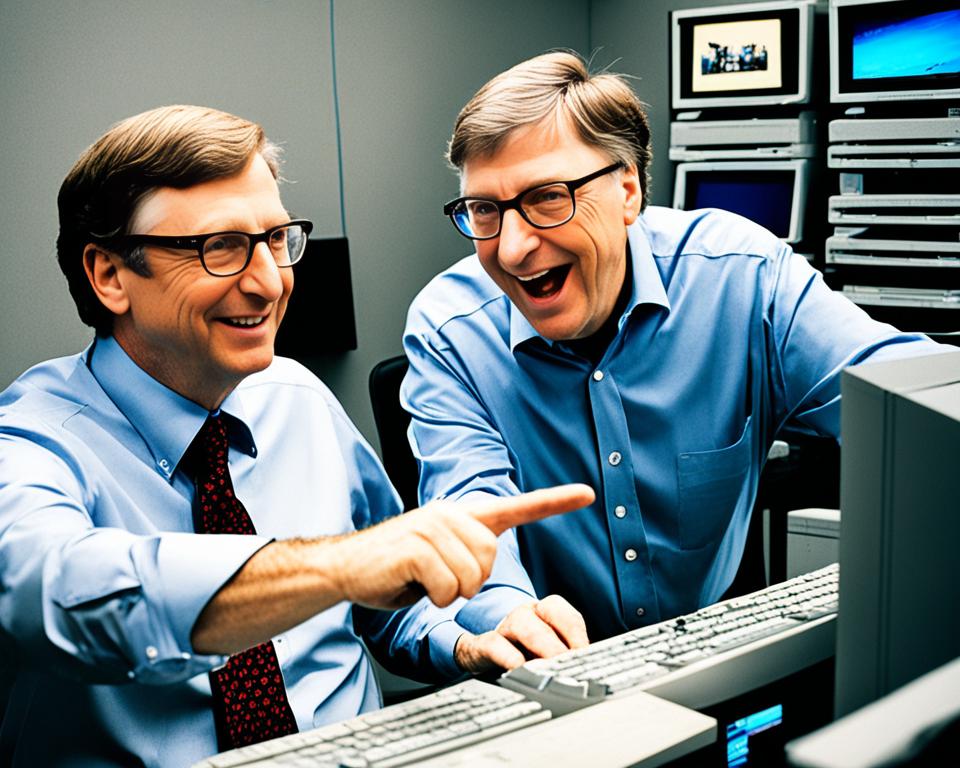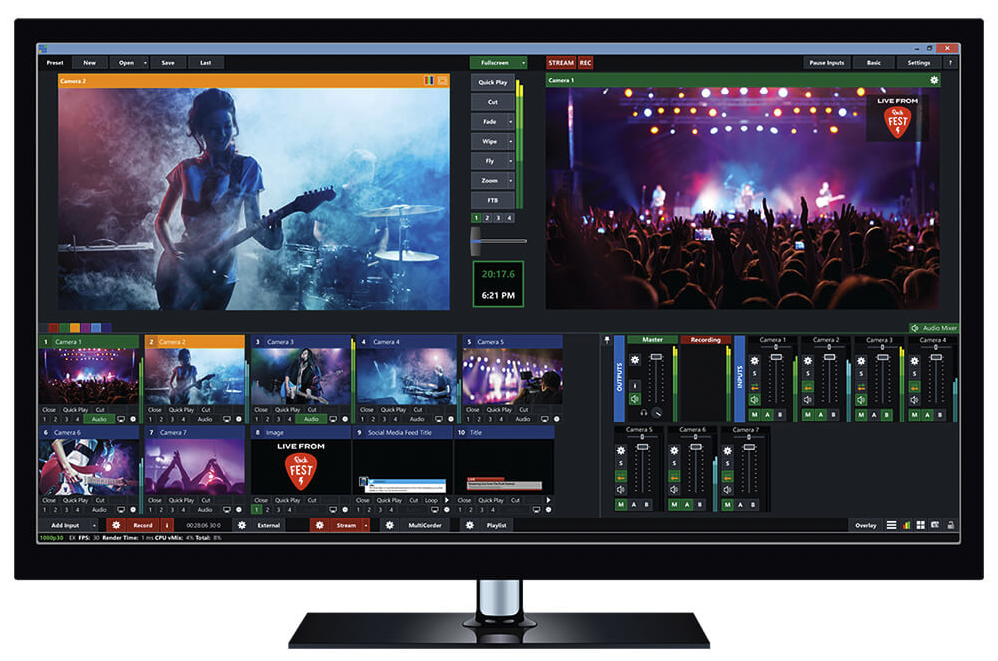Bill Gates, the renowned business magnate and philanthropist, is best known as the co-founder of Microsoft Corporation, one of the world’s most successful technology companies. Gates’ journey to starting Microsoft began in 1975, when he and his childhood friend, Paul Allen, embarked on a groundbreaking venture that would change the world of computing forever.
Their vision was to develop software for the Altair 8800, a personal computer that was gaining popularity at the time. With their passion for technology and programming expertise, Gates and Allen founded Microsoft in Albuquerque, New Mexico. Initially, the company’s name was spelled “Micro-Soft,” derived from the words “microprocessors” and “software.”
As their software gained recognition, Microsoft relocated its headquarters to Bellevue, Washington in 1979. From there, the company experienced rapid growth and achieved remarkable milestones. In 1981, Microsoft licensed their MS-DOS operating system to IBM, cementing their position as a key player in the personal computer industry. This partnership with IBM propelled Microsoft to global recognition and set the stage for their future success.
Microsoft’s impact continued to grow with the introduction of Windows in 1985, which revolutionized the computing experience with its graphical user interface. The launch of Windows 95 in 1995 further solidified Microsoft’s dominance, as it sold millions of copies within weeks. The company’s expansion into web browsing with Internet Explorer and the video game industry with Xbox further showcased their innovation and influence.
Today, Microsoft’s legacy extends beyond software. The company is a leader in cloud computing, artificial intelligence, and hardware devices. Bill Gates’ entrepreneurial journey and his role in the founding of Microsoft continue to inspire aspiring innovators in the technology industry.
Key Takeaways:
- Bill Gates co-founded Microsoft in 1975 with Paul Allen.
- Microsoft’s name was originally spelled as “Micro-Soft.”
- Microsoft achieved early success by licensing their MS-DOS operating system to IBM.
- The introduction of Windows revolutionized the computing experience.
- Microsoft’s expansion into web browsing and gaming further solidified its impact on the tech industry.
Table of Contents
Microsoft’s Early Years and Key Milestones
During the early years of Microsoft, the company focused on developing software for the Altair 8800, an early personal computer. One of their key achievements was successfully licensing their MS-DOS operating system to IBM for its first personal computer in 1981. This partnership with IBM allowed Microsoft to gain widespread recognition and establish a strong foothold in the personal computer industry.
In 1985, Microsoft made another major milestone with the release of Windows, a graphical user interface that revolutionized the computing experience. Windows introduced features like drop-down menus and scroll bars, improving user interaction and accessibility. This development marked a significant step in Microsoft’s growth timeline.
Windows 95, launched in 1995, further propelled Microsoft’s success. Within the first five weeks of its release, the operating system sold a staggering 7 million copies. This achievement further solidified Microsoft’s position as a technology powerhouse and showcased its ability to deliver groundbreaking products.
Additionally, in 1995, Microsoft introduced Internet Explorer, its web browser, which played a crucial role in shaping the future of the internet. With the combined success of Windows and Internet Explorer, Microsoft continued its upward trajectory and established itself as a dominant force in the technology industry.
Let’s take a closer look at Microsoft’s key milestones:
| Milestone | Year |
|---|---|
| Licensing MS-DOS to IBM | 1981 |
| Release of Windows | 1985 |
| Launch of Windows 95 | 1995 |
| Introduction of Internet Explorer | 1995 |
This table provides a summary of Microsoft’s key milestones during its early years. These achievements laid the foundation for Microsoft’s growth and success in the decades to come.
Microsoft’s Expansion and Impact on the Tech Industry
As Microsoft continued to expand its presence in the tech industry, the company ventured into new territories, making waves with its innovative products and services. One of the significant milestones in Microsoft’s expansion was its entry into the video game market with the launch of the Xbox console in 2001. This move marked a significant shift for the company, as it delved into hardware production alongside its software offerings. The Xbox console line went on to become a massive success, garnering a devoted fan base and revolutionizing the gaming industry.
However, Microsoft’s journey towards expansion wasn’t without its challenges. In the late 1990s and early 2000s, the company faced legal obstacles, including an antitrust lawsuit from the U.S. Department of Justice and 20 state attorneys general. Despite these legal battles, Microsoft’s influence on the tech industry remained undeniable.
Microsoft’s suite of products, such as the renowned Microsoft Office and the widely used Windows operating system, became integral tools for both businesses and individuals worldwide. These offerings played a pivotal role in shaping the modern technological landscape and contributed to Microsoft’s enduring impact on the industry.
Furthermore, Microsoft’s advancements in technology solidified its position as a leader in the field. With the introduction of Azure, its cloud computing platform, Microsoft enabled businesses to harness the power of the cloud for enhanced productivity and scalability. Additionally, the development of the Surface tablet computers showcased Microsoft’s commitment to innovation and provided consumers with a new way to interact with technology.
Microsoft’s Impact on the Tech Industry
Microsoft’s expansion and influence have left an indelible mark on the tech industry. The company’s groundbreaking products and services have not only revolutionized various sectors but have also shaped the way people interact with technology in their daily lives.
Table: Microsoft’s Key Contributions to the Tech Industry
| Product/Innovation | Impact |
|---|---|
| Microsoft Office Suite | Standardized productivity tools and became essential for businesses and individuals. |
| Windows Operating System | Popularized graphical user interfaces and provided a user-friendly computing experience. |
| Azure Cloud Computing | Enabled businesses to scale and optimize operations through reliable cloud infrastructure. |
| Surface Tablet Computers | Introduced a new form factor and enhanced productivity on the go. |
Microsoft’s expansion and impact on the tech industry continue to shape the future of technology, cementing the company’s role as a driving force in technological advancement.
How Bill Gates Started Microsoft: The Untold Story
Bill Gates’ journey to starting Microsoft is a fascinating tale of entrepreneurial vision and determination. Alongside his childhood friend Paul Allen, Gates embarked on a mission to revolutionize the world of technology. It all began when they recognized the immense potential of microcomputers, particularly the Altair 8800.
While studying at Harvard University, Gates reached out to MITS, the company behind the Altair, with a bold proposition. He offered to develop an interpreter that would enable the microcomputer to run BASIC software. What made this proposition even more remarkable was the fact that Gates and Allen didn’t have access to the actual hardware. Undeterred, they created a working version of Altair BASIC using an emulator.
Their determination and ingenuity paid off when they presented the working version of Altair BASIC to MITS. The demonstration impressed the company, leading to an agreement to distribute their software. This pivotal moment marked the founding of Microsoft and laid the groundwork for the company’s future success.
In retrospect, Bill Gates’ role in Microsoft’s success cannot be overstated. His entrepreneurial journey and unwavering belief in the potential of personal computers propelled Microsoft to become one of the most influential technology companies in the world. Gates’ vision for Microsoft extended beyond software development; he aimed to empower individuals and businesses through technology.
Bill Gates’ Vision for Microsoft
Gates had a clear vision for Microsoft from the very beginning. He believed in the transformative power of software and its ability to enhance productivity and innovation. Microsoft’s mission under Gates’ leadership was to create user-friendly software that would empower individuals and businesses, making technology accessible to all.
One of Gates’ key goals was to put a computer on every desk and in every home. This vision drove Microsoft’s product development and expansion, leading to the creation of iconic software products like MS-DOS, Windows, and Microsoft Office.
The Role of Bill Gates in Microsoft’s Success
Bill Gates played a pivotal role in shaping Microsoft’s success through his leadership, strategic decision-making, and relentless pursuit of excellence. As the co-founder and longtime CEO of Microsoft, Gates oversaw the company’s growth from a small startup to a global technology powerhouse.
Gates had a remarkable ability to anticipate market trends and identify opportunities for innovation. His foresight led Microsoft to diversify its product portfolio beyond software, venturing into hardware with the introduction of the Xbox gaming console and the Surface tablet computers.
Furthermore, Gates fostered a culture of innovation within Microsoft, encouraging employees to think creatively and push the boundaries of what was possible. His hands-on involvement in product development and his passion for technology propelled Microsoft to achieve numerous milestones and breakthroughs.
In conclusion, Bill Gates’ entrepreneurial journey and vision for Microsoft laid the foundation for one of the most influential technology companies in history. From humble beginnings to global dominance, Gates’ remarkable leadership and unwavering commitment to innovation have forever shaped the world of technology.
Key Milestones in Bill Gates’ Journey
| Year | Milestone |
|---|---|
| 1975 | Bill Gates and Paul Allen found Microsoft |
| 1981 | Microsoft licenses MS-DOS to IBM |
| 1985 | Launch of Windows, a graphical user interface |
| 1995 | Introduction of Windows 95 and Internet Explorer |
| 2001 | Microsoft enters the video-game market with Xbox |
Microsoft’s Funding and Going Public
Unlike many modern tech startups, Microsoft did not rely on external investors for funding in its early years. Instead, Bill Gates and Paul Allen identified a client, MITS, that they believed they could help with their software development skills. They developed Altair BASIC and earned money by serving MITS’ needs.
Microsoft’s Initial Investment: Utilizing Strategic Partnerships
During Microsoft’s early years, Bill Gates and Paul Allen recognized the potential value of forging strategic partnerships to finance their endeavors. They strategically identified MITS, a client in need of their software development expertise, as an opportunity for initial funding. By developing and selling Altair BASIC, Microsoft’s first successful product, the company secured its early financial stability.
Through this pivotal partnership, Microsoft not only provided a solution for MITS’ software needs but also catalyzed its own growth. This mutually beneficial relationship enabled Microsoft to further invest in research and development, actively shaping the future of personal computing.
Going Public: Microsoft’s Milestone Moment
After laying the groundwork with successful products and strategic partnerships, Microsoft took a crucial step in its journey by going public. On March 13, 1986, Microsoft made its initial public offering (IPO), becoming a publicly traded company on the NASDAQ stock exchange.
The decision to go public was driven by a desire to accelerate the company’s expansion and provide additional capital for future growth. The IPO not only injected significant funds into Microsoft but also signaled a vote of confidence from the market in the company’s potential.
Microsoft’s Stock Performance: A Testament to Growth
Following its IPO, Microsoft experienced exponential growth, solidifying its position as a technology powerhouse. The company’s stock performance reflects the market’s recognition of Microsoft’s success and potential.
Over the years, Microsoft’s stock has consistently outperformed the market and delivered favorable returns to shareholders. This sustained growth can be attributed to the company’s ability to adapt to emerging technologies, expand into new markets, and innovate across various product lines.
| Year | Microsoft Stock Performance |
|---|---|
| 1995 | +121% |
| 2000 | +9% |
| 2010 | +42% |
| 2020 | +42% |
Table: Microsoft’s Stock Performance Over the Years
Microsoft’s remarkable stock performance highlights the company’s ability to consistently deliver value to its shareholders. As a result, Microsoft has become one of the most valuable and influential companies in the world, with a market capitalization that continues to grow.
Conclusion
Bill Gates’ entrepreneurial journey and his co-founding of Microsoft with Paul Allen have left an indelible mark on the technology industry. Through their vision and innovation, they built a company that has become synonymous with innovation and growth. Microsoft’s impact on technology cannot be overstated, as it has revolutionized the way we use computers and software.
From its beginnings in the 1970s, Microsoft has experienced remarkable growth and success. It started with software development for the Altair 8800 and went on to create groundbreaking products like MS-DOS, Windows, and Office. The company’s expansion into new areas such as gaming with Xbox, cloud computing with Azure, and hardware with Surface further solidified its position as a technological powerhouse.
Bill Gates’ achievements extend beyond the success of Microsoft. He has become one of the most influential figures in the tech industry, with a focus on philanthropy through the Bill & Melinda Gates Foundation. His dedication to improving global health, education, and access to technology is a testament to his lasting legacy.
In conclusion, Bill Gates’ leadership, foresight, and relentless pursuit of innovation have propelled Microsoft to its position as a dominant force in the technology industry. His vision and the company’s growth have shaped the way we interact with technology, leaving a profound impact on our lives and the world at large.


